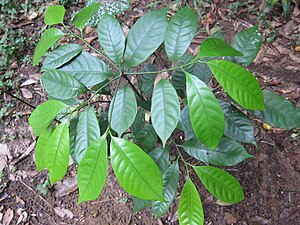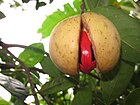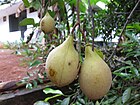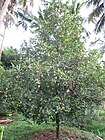Note: This is a project under development. The articles on this wiki are just being initiated and broadly incomplete. You can Help creating new pages.
Difference between revisions of "Myristica fragrans - Mayaphala"
(→Fruit) |
(→List of Ayurvedic medicine in which the herb is used) |
||
| (11 intermediate revisions by the same user not shown) | |||
| Line 3: | Line 3: | ||
==Uses== | ==Uses== | ||
| − | {{Uses|Bleeding piles}}, {{Uses|Rectal bleeding}}, {{Uses|Irritable bowel syndrome}}, {{Uses|Liver disorders}}, {{Uses|Rectal prolapse}}, {{Uses|Uterine prolapse}}, {{Uses|Leucorrhea}}, {{Uses|Vaginitis}}, {{Uses|Toothache}} | + | {{Uses|Bleeding piles}}, {{Uses|Rectal bleeding}}, {{Uses|Irritable bowel syndrome}}, {{Uses|Liver disorders}}, {{Uses|Rectal prolapse}}, {{Uses|Uterine prolapse}}, {{Uses|Leucorrhea}}, {{Uses|Vaginitis}}, {{Uses|Toothache}}, {{Uses|Headache}}, {{Uses|Dysentery}}, {{Uses|Pimples}}, {{Uses|Cracked foot}}, {{Uses|Impotence}}, {{Uses|Toothache}}, {{Uses|Insomnia}}, {{Uses|Cough}}<ref name="Karnataka Medicinal Plants"/>. |
==Parts Used== | ==Parts Used== | ||
| − | {{Parts Used|Leaves}}. | + | {{Parts Used|Leaves}}, {{Parts Used|Jakayi}}<ref name="Karnataka Medicinal Plants"/>. |
==Chemical Composition== | ==Chemical Composition== | ||
| Line 12: | Line 12: | ||
==Common names== | ==Common names== | ||
| − | {{Common names|kn= | + | {{Common names|kn=ಜಾಕಾಯಿ Jakayi, ಜಾತೀಫಲ Jatiphala |ml=Majakaanee, Mashikkay|sa=Mayaphala, Majuphul|ta=Machakaai, Masikki|te=Machikaaya|hi=Maajoophal, Majuphal|en=Oak Galls, Magic Nuts}}<ref name="Karnataka Medicinal Plants"/> |
==Properties== | ==Properties== | ||
| Line 35: | Line 35: | ||
==Identification== | ==Identification== | ||
===Leaf=== | ===Leaf=== | ||
| − | {{Leaf|Simple| | + | {{Leaf|Simple|Alternate|Estipulate; petiole 9-15 mm long, slender, grooved above, glabrous; lamina 9-18 x 2.5-6 cm, elliptic}}<ref name="Leaf"/> |
===Flower=== | ===Flower=== | ||
| − | {{Flower|Unisexual||Yellow|9-12| | + | {{Flower|Unisexual||Yellow|9-12|Male flowers: 3-5 in axillary cymes, urceolate; pedicels drooping; bracts deciduous; bracteoles persistent. Flowering from June to September}} |
===Fruit=== | ===Fruit=== | ||
| − | {{Fruit|Fleshy capsule|5 cm|| | + | {{Fruit|Fleshy capsule|5 cm||Aril red, lacinate; seed brown|Fruiting from June to September}} |
===Other features=== | ===Other features=== | ||
==List of Ayurvedic medicine in which the herb is used== | ==List of Ayurvedic medicine in which the herb is used== | ||
| − | + | [[Dadimavaleha]], [[Nasika churna]], [[Mrita sanjeevani gulika]], [[Agnisandipana rasa]], [[Arimedaadi Taila]], [[Ashwagandhaadi rasaayana]], [[Ashwinikumaara rasa]], [[Ardakaandava Lehya]], [[Aaditya rasa]], [[Ananda Bairava rasa]], [[Aarogyakara Kasturi Maatre]], [[Eranda Paaka]], [[Karpoora Rasa]], [[Karpooraadi Churna]], [[Karpooraadi Rasa]], [[Kasturyadi Gutika]], [[Coughlet]], [[Kaamini Vidraavan rasa]], [[Kumariyaasava]], [[Khadiraarishta]], [[Chandanaadi Taila]], [[Jatiphalaadi Churna]], [[Jirakaarishta]]<ref name="Ayurvedic preparations"/> | |
| − | |||
| − | |||
| − | |||
| − | <ref name="Ayurvedic preparations"/> | ||
==Where to get the saplings== | ==Where to get the saplings== | ||
| Line 57: | Line 53: | ||
==How to plant/cultivate== | ==How to plant/cultivate== | ||
| − | Seed - best sown when fresh. Germination usually takes place in 5 - 6 weeks. Seed in the shell takes some 4 - 6 weeks to germinate | + | Seed - best sown when fresh. Germination usually takes place in 5 - 6 weeks. Seed in the shell takes some 4 - 6 weeks to germinate.<ref name="How to plant/cultivate"/> |
==Commonly seen growing in areas== | ==Commonly seen growing in areas== | ||
| Line 75: | Line 71: | ||
==References== | ==References== | ||
| + | <references> | ||
| + | <ref name="chemical composition">[https://www.ayurtimes.com/quercus-infectoria-manjakani-majuphal-benefits-uses-side-effects/ Phytochemistry]</ref> | ||
| − | < | + | <ref name="Leaf">[https://ayusri.com/eherb-Majuphala Morphology]</ref> |
| − | <ref name=" | + | <ref name="Ayurvedic preparations">[https://easyayurveda.com/2014/11/26/jaiphal-nutmeg-myristica-fragrans-uses-dose-side-effects/ Ayurvedic preparations]</ref> |
| − | <ref name=" | + | <ref name="How to plant/cultivate">[http://tropical.theferns.info/viewtropical.php?id=Myristica+fragrans CULTIVATION PRACTICES]</ref> |
| − | |||
| − | <ref name=" | + | <ref name="Karnataka Medicinal Plants">”Karnataka Medicinal Plants Volume-3” by Dr.M. R. Gurudeva, Page No.470, Published by Divyachandra Prakashana, #6/7, Kaalika Soudha, Balepete cross, Bengaluru</ref> |
</references> | </references> | ||
==External Links== | ==External Links== | ||
| − | * [https://www. | + | * [https://www.ayurtimes.com/quercus-infectoria-manjakani-majuphal-benefits-uses-side-effects/ Myristica fragrans on ayurtimes.com] |
| − | * [https://www. | + | * [https://www.bimbima.com/herbs/majuphal-oak-galls-information-medicinal-uses-and-side-effects/60/ Myristica fragrans on ayurtimes.com] |
| + | |||
* [http://ayurvedicmedicinalplants.in/content/mayaphala Mayaphala on ayurvedic medicinal plants] | * [http://ayurvedicmedicinalplants.in/content/mayaphala Mayaphala on ayurvedic medicinal plants] | ||
[[Category:Herbs]] | [[Category:Herbs]] | ||
[[Category:Myristicaceae]] | [[Category:Myristicaceae]] | ||
Latest revision as of 17:39, 6 September 2023
Quercus infectoria is a species of oak, bearing galls that have been traditionally used for centuries in Asia medicinally. Quercus infectoria or locally known as Manjakani in Malaysia
Contents
- 1 Uses
- 2 Parts Used
- 3 Chemical Composition
- 4 Common names
- 5 Properties
- 6 Habit
- 7 Identification
- 8 List of Ayurvedic medicine in which the herb is used
- 9 Where to get the saplings
- 10 Mode of Propagation
- 11 How to plant/cultivate
- 12 Commonly seen growing in areas
- 13 Photo Gallery
- 14 References
- 15 External Links
Uses
Bleeding piles, Rectal bleeding, Irritable bowel syndrome, Liver disorders, Rectal prolapse, Uterine prolapse, Leucorrhea, Vaginitis, Toothache, Headache, Dysentery, Pimples, Cracked foot, Impotence, Toothache, Insomnia, Cough[1].
Parts Used
Chemical Composition
Gallic Acid & Tannic Acid are found in Manjakani[2]
Common names
| Language | Common name |
|---|---|
| Kannada | ಜಾಕಾಯಿ Jakayi, ಜಾತೀಫಲ Jatiphala |
| Hindi | Maajoophal, Majuphal |
| Malayalam | Majakaanee, Mashikkay |
| Tamil | Machakaai, Masikki |
| Telugu | Machikaaya |
| Marathi | NA |
| Gujarathi | NA |
| Punjabi | NA |
| Kashmiri | NA |
| Sanskrit | Mayaphala, Majuphul |
| English | Oak Galls, Magic Nuts |
Properties
Reference: Dravya - Substance, Rasa - Taste, Guna - Qualities, Veerya - Potency, Vipaka - Post-digesion effect, Karma - Pharmacological activity, Prabhava - Therepeutics.
Dravya
Rasa
Kashaya (Astringent)
Guna
Laghu (Light), Ruksha (Dry)
Veerya
Sheeta (cold)
Vipaka
Katu (Pungent)
Karma
Kapha, Pitta
Prabhava
Habit
Identification
Leaf
| Kind | Shape | Feature |
|---|---|---|
| Simple | Alternate | Estipulate; petiole 9-15 mm long, slender, grooved above, glabrous; lamina 9-18 x 2.5-6 cm, elliptic |
Flower
| Type | Size | Color and composition | Stamen | More information |
|---|---|---|---|---|
| Unisexual | Yellow | 9-12 | Male flowers: 3-5 in axillary cymes, urceolate; pedicels drooping; bracts deciduous; bracteoles persistent. Flowering from June to September |
Fruit
| Type | Size | Mass | Appearance | Seeds | More information |
|---|---|---|---|---|---|
| Fleshy capsule | 5 cm | Aril red, lacinate; seed brown | Fruiting from June to September | {{{6}}} |
Other features
List of Ayurvedic medicine in which the herb is used
Dadimavaleha, Nasika churna, Mrita sanjeevani gulika, Agnisandipana rasa, Arimedaadi Taila, Ashwagandhaadi rasaayana, Ashwinikumaara rasa, Ardakaandava Lehya, Aaditya rasa, Ananda Bairava rasa, Aarogyakara Kasturi Maatre, Eranda Paaka, Karpoora Rasa, Karpooraadi Churna, Karpooraadi Rasa, Kasturyadi Gutika, Coughlet, Kaamini Vidraavan rasa, Kumariyaasava, Khadiraarishta, Chandanaadi Taila, Jatiphalaadi Churna, Jirakaarishta[4]
Where to get the saplings
Mode of Propagation
How to plant/cultivate
Seed - best sown when fresh. Germination usually takes place in 5 - 6 weeks. Seed in the shell takes some 4 - 6 weeks to germinate.[5]
Commonly seen growing in areas
Evergreen forest, Western ghats
Photo Gallery
References
- ↑ 1.0 1.1 1.2 ”Karnataka Medicinal Plants Volume-3” by Dr.M. R. Gurudeva, Page No.470, Published by Divyachandra Prakashana, #6/7, Kaalika Soudha, Balepete cross, Bengaluru
- ↑ Phytochemistry
- ↑ Morphology
- ↑ Ayurvedic preparations
- ↑ CULTIVATION PRACTICES
External Links
- Ayurvedic Herbs known to be helpful to treat Bleeding piles
- Ayurvedic Herbs known to be helpful to treat Rectal bleeding
- Ayurvedic Herbs known to be helpful to treat Irritable bowel syndrome
- Ayurvedic Herbs known to be helpful to treat Liver disorders
- Ayurvedic Herbs known to be helpful to treat Rectal prolapse
- Ayurvedic Herbs known to be helpful to treat Uterine prolapse
- Ayurvedic Herbs known to be helpful to treat Leucorrhea
- Ayurvedic Herbs known to be helpful to treat Vaginitis
- Ayurvedic Herbs known to be helpful to treat Toothache
- Ayurvedic Herbs known to be helpful to treat Headache
- Ayurvedic Herbs known to be helpful to treat Dysentery
- Ayurvedic Herbs known to be helpful to treat Pimples
- Ayurvedic Herbs known to be helpful to treat Cracked foot
- Ayurvedic Herbs known to be helpful to treat Impotence
- Ayurvedic Herbs known to be helpful to treat Insomnia
- Ayurvedic Herbs known to be helpful to treat Cough
- Herbs with Leaves used in medicine
- Herbs with Jakayi used in medicine
- Herbs with common name in Kannada
- Herbs with common name in Hindi
- Herbs with common name in Malayalam
- Herbs with common name in Tamil
- Herbs with common name in Telugu
- Herbs with common name in Sanskrit
- Herbs with common name in English
- Habit - Shrub
- Index of Plants which can be propagated by Seeds
- Index of Plants which can be propagated by Cuttings
- Herbs that are commonly seen in the region of Evergreen forest
- Herbs that are commonly seen in the region of Western ghats
- Herbs
- Myristicaceae








